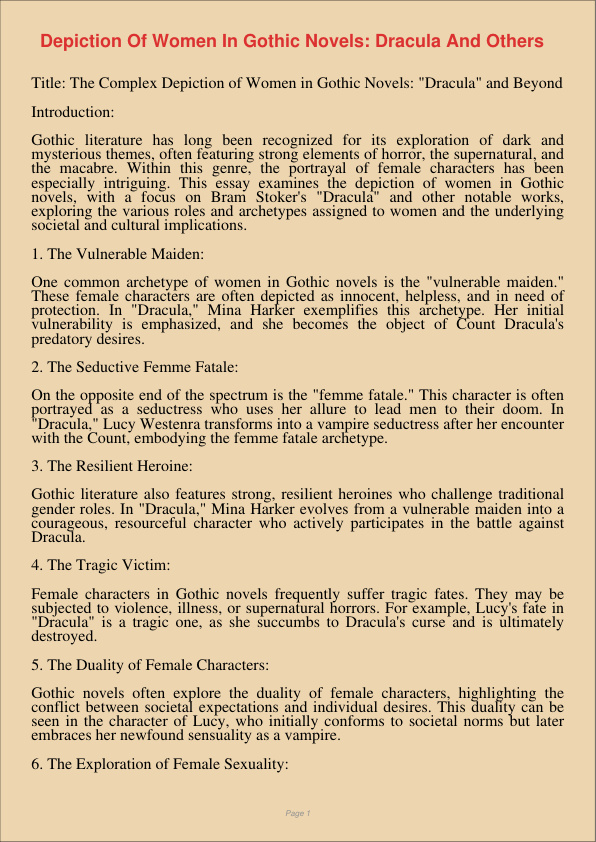Depiction Of Women In Gothic Novels Dracula And Others
Jan 12, 2024
gothic novels
women
Gender & Sexual Studies
Marketing
Title: The Complex Depiction of Women in Gothic Novels: “Dracula” and Beyond
Introduction:
Gothic literature has long been recognized for its exploration of dark and mysterious themes, often featuring strong elements of horror, the supernatural, and the macabre. Within this genre, the portrayal of female characters has been especially intriguing. This essay examines the depiction of women in Gothic novels, with a focus on Bram Stoker’s “Dracula” and other notable works, exploring the various roles and archetypes assigned to women and the underlying societal and cultural implications.
- The Vulnerable Maiden:
One common archetype of women in Gothic novels is the “vulnerable maiden.” These female characters are often depicted as innocent, helpless, and in need of protection. In “Dracula,” Mina Harker exemplifies this archetype. Her initial vulnerability is emphasized, and she becomes the object of Count Dracula’s predatory desires.
- The Seductive Femme Fatale:
On the opposite end of the spectrum is the “femme fatale.” This character is often portrayed as a seductress who uses her allure to lead men to their doom. In “Dracula,” Lucy Westenra transforms into a vampire seductress after her encounter with the Count, embodying the femme fatale archetype.
- The Resilient Heroine:
Gothic literature also features strong, resilient heroines who challenge traditional gender roles. In “Dracula,” Mina Harker evolves from a vulnerable maiden into a courageous, resourceful character who actively participates in the battle against Dracula.
- The Tragic Victim:
Female characters in Gothic novels frequently suffer tragic fates. They may be subjected to violence, illness, or supernatural horrors. For example, Lucy’s fate in “Dracula” is a tragic one, as she succumbs to Dracula’s curse and is ultimately destroyed.
- The Duality of Female Characters:
Gothic novels often explore the duality of female characters, highlighting the conflict between societal expectations and individual desires. This duality can be seen in the character of Lucy, who initially conforms to societal norms but later embraces her newfound sensuality as a vampire.
- The Exploration of Female Sexuality:
Gothic literature provides a platform for the exploration of female sexuality, often in a repressive and patriarchal society. The seductive and sensual elements in characters like Lucy in “Dracula” challenge societal norms regarding female sexuality.
- Social Commentary and Empowerment:
Gothic novels, including “Dracula,” can be read as a reflection of societal fears and desires. The evolving portrayal of female characters in the genre can also be seen as a reflection of changing views on gender and power. Mina’s transformation from a passive character to an empowered heroine in “Dracula” can be interpreted as a commentary on women’s evolving roles in society.
Conclusion:
The depiction of women in Gothic novels, including “Dracula,” is a multifaceted exploration of female identity, sexuality, and societal norms. These characters often embody archetypes that reveal the complex and evolving nature of women’s roles in literature and society. The genre allows for the examination of women’s vulnerabilities and strengths, the duality of their characters, and their struggles for empowerment and agency. The portrayal of women in Gothic novels serves as a reflection of the societal and cultural contexts in which these works were written, and it continues to be a rich and intriguing area of study in the world of literature and gender studies.
